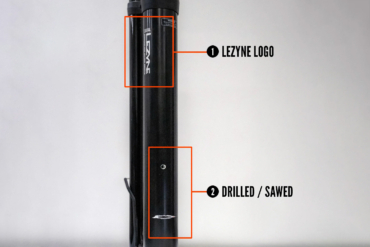Carbon bike builders want you to buy new frames when you break one. We’re here to say you don’t have to.

Mountain bikers fully adopted the use of carbon as a frame material over the past decade, but not without hesitation. The lightweight and desirable ride characteristics outweigh the material’s impact fragility and premium price in the mind of most riders I know.
But stories of small cracks leading to unrideable frames also abound.

I personally had three frames already in my stable of “retired” broken carbon frames before an experience in New Zealand led me down the path toward repair.
“Just send it to the shop and they’ll fix it right up,” the nonchalant Kiwi told me. And the journey began.
‘Sketchy’ World Of Carbon Bike Repair
And so I learned about the seemingly sketchy world of repairing a carbon fiber mountain bike. Universally, every single bike brand I talked to told me this was NOT A GOOD IDEA. They spouted all sorts of reasons from liability concerns, to the difficulty of the procedure, to the danger of a repair failing during extreme riding.
The brands all suggested repair was not worth the risk and buying a discounted replacement was the safest option. Most brands warranty frames against manufacturing defects. In all but one of the frames, brands declared damage unequivocally my fault (or the airlines’, shippers’, etc).
DIY Carbon Repair?
I bought a $99 DIY carbon repair kit from Amazon and tried my hand at a repair. In the end, it was more than I felt comfortable with, and the voices of the bike manufacturer’s warning echoed in my head: “What if it breaks when you are riding?”
My repair was ugly and rough. I was too timid to do anything but ride lightly on pavement.
Professional Carbon Bike Repair

But then I found Appleman Cycles based out of Minneapolis.
From the website:
“Appleman Bicycles can repair your damaged, broken, busted, or cracked carbon fiber frame! Nearly every carbon fiber frame can be repaired no matter how severe the damage. I use my vast knowledge and experience in advanced carbon fiber structure repair to bring your bike back to it’s original strength, safely. With a turnaround time of 3 days, you’ll have your bike back quickly.
It’s a myth that carbon can’t be repaired. In fact, carbon fiber is one of the most repairable materials and each Appleman repair is covered by a 10 year warranty! Repairs add no measurable weight and don’t alter the ride of the bike.
–
Don’t worry… get it repaired!”
 Oh snap! Carbon frame before repair
Oh snap! Carbon frame before repair
Interview: Carbon Frame Repair Expert
Matt Appleman has fixed carbon frames since 2011. He also repairs wind turbine blades in his role as a composite engineer.
I sent him two frames and a host of questions. I wanted to know if his repairs would last.
Most bike manufacturers recommend against this practice – but your website (and others) claim it is very safe. Why do you think there is a disconnect?
Most people don’t know that carbon fiber is the most repairable material. As they say in The Princess Bride, “Anyone who says differently is selling something.” Repair is bad business for big manufacturers. Legally speaking, they want to limit their liability. Financially, they want to sell you a new frame.
How many carbon repairs (frames) have you done?
I’ve done 350 frame repairs (1,000+ counting wind turbine repair). I’m a one-man shop and split my time between building custom carbon fiber frames and repair work.
Are there certain breaks that you would not repair? What and Why?
I don’t repair carbon fiber components: handlebars, forks, seat posts and the like. It’s cheaper to get a new part.
Rims: you have so much heat, friction, and extremely high forces on very small areas that repair isn’t practical. On the other hand, disc wheels (as in TT disc wheels) are repairable, except along the brake track. It’s pretty common for them to get pierced by a pedal during transportation.
I tend not to repair damaged or loose metal bottom bracket sleeves. These sleeves often loosen up because of poor frame design, and I can’t fix poor design. Sure, I could re-glue it and it might last you a season, but I don’t perform a repair if it’s not going to last for the long haul.
Have you ever had a repair fail?
Nope. I don’t repair a frame unless I know it’s going to be durable and outlast the rest of the bike! Strength and durability are my primary concerns. Sometimes someone brings me a frame that can’t be repaired safely and I hate to be the bearer of bad news, but a repair doesn’t make sense in some situations.
Are there different concerns/steps in repairing a damaged road bike vs. mountain bike?
Every frame is unique whether it’s a road or mountain frame, so it gets a unique repair. I dig into the frame and see what is damaged, how deep, and to what extent. Repair is part art and part science. I combine these two to evaluate, design, and perform the repair.
So yes, a mountain bike repair will be different than a road bike repair because the bike was (hopefully) designed to be stronger. That being said, even repairing the seat stays of two road bikes will be slightly different as they’re different bikes. I can read carbon fiber damage like a book.
What is the average price range of a carbon repair from your shop?
The vast majority of repairs are $300 for your typical seat stay, chain stay, and top tube damages. Other repairs range from $250-$400.
Turnaround time?
Standard turnaround time is one to two weeks. I offer expedited repair of about 24 hours for an additional $50. I also have the ability to do same day turnarounds for emergencies.
Being that I don’t do any paint work, I am able to turn repairs around quickly. Paint adds a lot of time and cost to the repair. I’m very practical and structurally-minded when doing repairs so I choose to show raw repair.
It’s also a myth that carbon fiber needs to be “protected” or “covered” so that the elements don’t damage it. This is false. In fact, carbon fiber/epoxy is chemically inert and doesn’t react to the elements.
What is the most technical/difficult part of the repair process?
I think carbon repair as a whole is all technical and each step has its own technical aspects. I’ve been doing repairs long enough it has become second nature, but I really enjoy the breadth of knowledge required of the repair process. Diagnosing damage, paint removal, layup design, applying the layup to the frame — it’s all technical, and requires a lot of practice and skill to perform efficiently.
What are the most common things you repair?
Seat stays and chainstays are by far the most damaged tubes. The stays are wider on the frame and less protected by the rider in the event of a crash. Seat stays are especially prone to damage as they are the least structural tube of the frame and the most exposed.
Do you make custom frames?
Yup. I build full carbon fiber frames for road, CX, mountain, and gravel riding. I customize every tube to the rider’s height, weight, and riding style. This deep level of customization through varying carbon materials, layup schedules, and diameter helps create the wonderful, lively ride Appleman is known for. Doing repair certainly upped my custom frame builds as well. When doing repairs I get great insight on what breaks, why, and where. I take these cues and design my frames to be tougher, stronger, and more durable than mass produced bikes.
Repaired Carbon-Fiber Frames Tested
I’ve repaired four frames total now (both at Appleman and a shop in New Zealand), and spent the last season training and racing on these repaired frames. The first few rides always spooked me going hard into any rough section or fast corner. But I soon forgot, so much so I’ve loaned the bikes out to other traveling racers with full confidence.
The only downside I can think of is that now I am even rougher on my bikes, taking less care in packing my bike for long flights and bumpy truck rides.
But as they say, “diamonds last forever.” And diamonds indeed are made of carbon.







